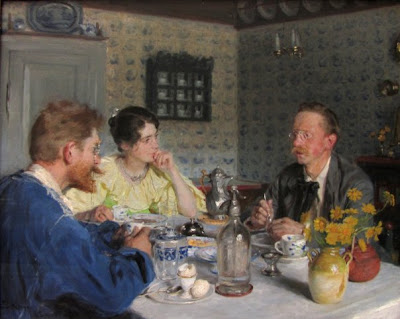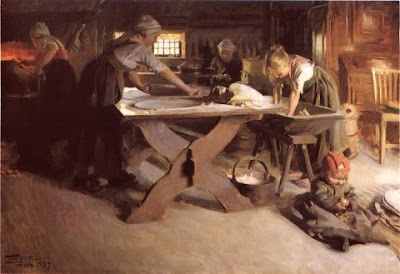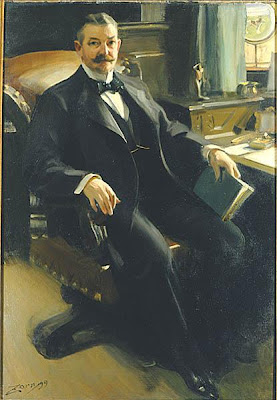 Assuming the sun is not shining directly through the window, the daylight that enters a room from outside is a soft source, meaning the light comes from a broad area and it doesn't cast hard-edged shadows. In this group portrait by Peder Krøyer (1851-1909), note how the shadow cast by the vase quickly dissolves into blurry edges.
Assuming the sun is not shining directly through the window, the daylight that enters a room from outside is a soft source, meaning the light comes from a broad area and it doesn't cast hard-edged shadows. In this group portrait by Peder Krøyer (1851-1909), note how the shadow cast by the vase quickly dissolves into blurry edges. When window or doorway light falls on a floor, there's often a lot of fall-off, or weakening of the light, as you travel back from the window, as with this interior scene by Anders Zorn (1860-1920). This is because the amount of window light available is usually in proportion to how large a slice of the blue sky you can see from a given point in the room.
When window or doorway light falls on a floor, there's often a lot of fall-off, or weakening of the light, as you travel back from the window, as with this interior scene by Anders Zorn (1860-1920). This is because the amount of window light available is usually in proportion to how large a slice of the blue sky you can see from a given point in the room. Even though Zorn used a very limited palette, he loved to play with the relationship between the slightly cool window light and the relatively warm interior light from incandescent or flame-based lamps.
Even though Zorn used a very limited palette, he loved to play with the relationship between the slightly cool window light and the relatively warm interior light from incandescent or flame-based lamps.Thanks, Tim A. And thanks to BoingBoing for picking up the studio shot.
See a bunch more high-res images by Krøyer at Tim's blog.







15 comments:
Great post, perhaps another excerpt from the forthcoming book?
You mention BoingBoing running the studio shot. David Apatoff had an excellent post yesterday about studios:
http://illustrationart.blogspot.com/
Fortunately, yours isn't shown "empty" for the same reason as those in his post...
Steve, thanks for that link to the interesting post by David Apatoff.
And yes, window light will be one part of a whole chapter that covers light sources:
Direct Sunlight
Overcast Light
Window Light
Candlelight and Firelight
Indoor Electric Light
Streetlights and Night Conditions
Luminescence
Hidden Light Sources
The pictures in this blog post are different from the ones in the book. The body of the book will have all new paintings by me, but I start off with large reproductions of:
Hiremy-Hirschl
Velazquez
Vermeer
Bouguereau
Gerome
Stanhope Forbes
Millais
Streeton
Shishkin
Church
Durand
Mucha
Harry Anderson
Lovell
and Walter Everett
Regardless of what images you use in the book, thanks for the introduction to Kroyer (I don't know how to type the o with a line through it). I love this triple portrait. Based on the link you gave to his Wiki biography, it seems the figure on the left is Kroyer and the woman is his wife. Wonderful sense of space and a moment frozen in time. Her thoughtful expression and the life in her hands are especially striking.
""Even though Zorn used a very limited palette""--One of the great myths of Modern Times!
from the article Sweden's Sargent, by Bob Bahr
Birgitta Sandström is the museum director of the Zorn Collections, which includes the artist's residence, estate, and museum in Mora, Sweden.
Sandström had difficulty even comprehending the assumption that Zorn worked with the specialized palette associated with him. She reports that 17 tubes of cobalt alone are represented among the 243 tubes of paint left by Zorn in his studio in Mora.
~It would be great if you or a reader could get an official list of all 243 colours. What a scoop!!!
øøøøøøøøøøøøøøøøøøøøøøøøøøøøøøøøøøøøø
अर्जुन: I'd be interested in more documentation about Zorn's working palette for portraits and interiors. Of course he owned blues and used them in his outdoor work, but both of the interior paintings in the post appear to be painted in a very limited gamut. The remaining contents of an artist's studio don't really tell us much about what he used in an individual painting.
I agree. The range of possibilities for any palette should be explored and understood. All paintings have a gamut once finished.
Zorn didn't wring all of his paintings from the same 4 tubes of paint. The dogma of a "Zorn Palette" limits and pre-burdens those that wish to study him, only to find they "just can't get it".
""The remaining contents of an artist's studio don't really tell us much about what he used in an individual painting."" ~It doesn't even tell you how many tubes were unwanted freebies from a paint maker looking for an endorsement. Regardless, seeing a list would be cool!
~Hej då!
side note but i'd love to find a good catalog of Kroyer - doesn't seem to exist under 100.00
PS I think Kroyer and Zorn influence Sorolla and visa versa side note the hispanic society has rehung the sorolla murals after a 2 year tour of spain - its up on 155th - and worth the trip!
http://www.hispanicsociety.org/hispanic/sorolla.htm
these murals are spectacular...talk about light!
Some beautiful pieces there. I really appreciate the little nugget about the amount of light in a given part of a room being in proportion to the amount of blue sky visible. One of those "light bulb" moments for me.
I am really looking forward to the book!
@Steve: you can make the Ø symbol by holding down the ALT keyand then typing 0216 on the number pad, or SHIFT+OPTION+O on a Mac. There are several keyboard shortcuts for special character sites, if you're interested.
Pen Name, yes, the Sorolla murals are fantastic. There's a nice article about them by Bob Bahr in the current American Artist magazine.
The only inexpensive book I've found with a lot of Kroyers is the exhibition catalog from "The Skagen Painters In a New Light," though none are currently available.
Tyler and Steve, thanks for that cool keyboard shortcut. The way I make an "ø" on a Mac is to click on that little flag on the right side of the topmost bar on your screen. If you click on "Show Character Palette" and then "Accented Latin," you can get any of the special characters.
great stuff. itichin' for the book.
Hey Guys, glad you used the pic James!
I took a bunch of photos and put them up on my blog, mostly high rez of Kroyer paintings, you can find them here,
http://timpaints.blogspot.com/2010/02/here-are-some-high-rez-phots-from-my.html
Thanks, Bill.
Tim, those Krøyer photos are incredible. I put the link on the end of the post.
Tyler and Jim,
Thanks for the character tutorial. Let's see if I learned anything...Peder KrØyer (using Tyler's method) and Peder KrØyer (using Jim's.) Sweet!
Mr. Gurney,
I don't have any further documentation regarding Zorn's palette other than my notes. The curator at his museum and a curator at the Stockholm national museum found the no-blues assertion so clearly false they wouldn't discuss it much at all, even though I asked the question in as many different ways as I could think of. I do have two pictures of his palettes that I took inside his studio in Mora, which is closed to the public. One clearly shows blue, and the other is scraped too clean to be definitive, one way or another.
I really feel the Zorn limited palette is more important as an idea than as historical fact. It doesn't make the concept any less important. But to associate Zorn with a blue-free palette is questionable.
Bob Bahr
Post a Comment